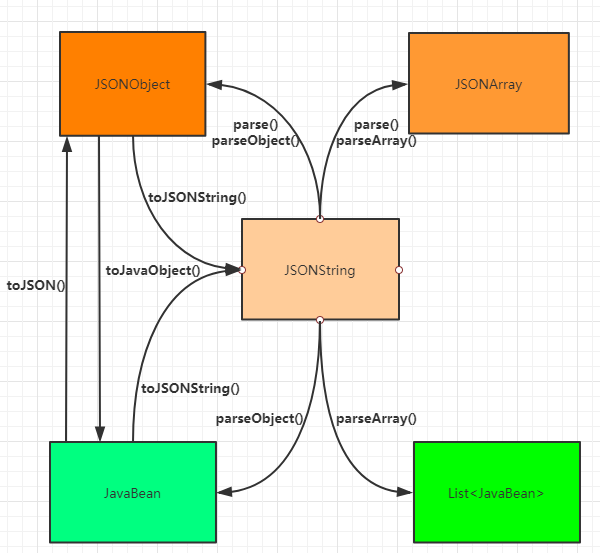FastJson中JSONString与各个对象的的转换关系及API示例
前言
JSON作为一种轻量级的数据交换格式,在我们日常的开发中使用十分广泛,就Java后端的开发工作中,JSON字符串与Java对象之间相互转换是常常遇到的操作。
虽然平时用到的挺多的,但是因为用于JSON处理的包有很多种,每种工具集的功能和使用方式也都不同,很容易在使用时造成混乱。
本文就结合
FastJson部分源码,简单整理了下常用的API及其使用示例
本文FastJson版本:1.2.54
转换图
根据FastJson源码大致整理出了这么一张转换图:

可以看到参与转换的对象主要有图中五种:
- JSONString:
json字符串 - JSONObject:
json对象 - JSONArray:
json对象数组 - JavaBean:
java对象 - List:
java对象集合
转化中用到的方法的方法名有如下几种:
- parse:
JSONString ==> JSONObject/JSONArray - parseObject:
JSONString ==> JSONObject/JavaBean - pareseArray:
JSONString ==> JSONObject/List<JavaBean> - toJSONString:
JavaBean/JSONObject ==> JSONString - toJSON:
JavaBean ==> JSONObject - toJavaObject:
JSONObject ==> JavaBean
常用API
本文种仅列举
平常使用频率较高的API,其他的重载方法可参考源码,大都是对序列化/反序列化过程进行定制化。
toJSONString
实现了json对象(
JSONObject)>json字符串(JSONString),和Java对象(JavaBean)>json字符串(JSONString)的转化

从源码中可以看到这一方法被重载了多个,我们日常会用到的有如下几个:
| 方法 : 返回值 | 参数说明 | 功能 |
|---|---|---|
| toJSONString(Object object):String | object: 需要进行序列化的对象javaBean或者JSONObject |
将对象序列化为json字符串 |
| toJSONString(Object object, boolean prettyFormat):String | prettyFormat:是否格式化输出json字符串 |
格式化输出json字符串 |
| toJSONString(Object object, SerializerFeature... features):String | features:序列化额外属性配置,非必填 |
根据指定属性进行序列化 |
| toJSONStringWithDateFormat(Object object, String dateFormat, SerializerFeature... features):String | dateFormat:日期格式(yyyy-MM-dd) |
序列化时格式化日期 |
这些方法中最常用的即为:toJSONString(Object object)
parse
实现了json字符串(
JSONString)>json对象(JSONObject),和json字符串(JSONString)>json对象数组(JSONArray)的转化

| 方法 : 返回值 | 参数说明 | 功能 |
|---|---|---|
| parse(String text):Object | text:json字符串 |
反序列化json字符串 |
parseObject
实现了json字符串(
JSONString)>json对象(JSONObject),和json字符串(JSONString)>Java对象(JavaBean)的转化

| 方法 : 返回值 | 参数说明 | 功能 |
|---|---|---|
| parseObject(String text):JSONObject | text:json字符串 |
反序列化json字符串为Json对象 |
| parseObject(String text, Class clazz):T | clazz:指定反序列化后的类 |
json字符串转java对象 |
| parseObject(String text, TypeReference type, Feature... features):T | type:构造转化类型,features:反序列化额外属性 |
json字符串转java对象 |
parseArray
实现了json字符串(
JSONString)==>json对象数组(JSONArray),和json字符串(JSONString)==>Java对象集合(List`)的转化

| 方法 : 返回值 | 参数说明 | 功能 |
|---|---|---|
| parseArray(String text) :JSONArray | text:json字符串 |
将json字符串反序列化为JSON数组对象 |
| parseArray(String text, Class clazz):List | clazz:指定转化后的类 |
将json字符串反序列化为java对象集合 |
toJSON/toJavaObject

toJSON()实现了Java对象(
JavaBean)==>Json对象(JSONObject)的转换toJavaObject()实现了Json对象(
JSONObject)==>Java对象(JavaBean)的转换
| 方法 : 返回值 | 参数说明 | 功能 |
|---|---|---|
| toJSON(Object javaObject):Object | javaObject:java对象 |
java对象转化为Json对象 |
| toJavaObject(JSON json, Class clazz):T | json:json对象,clazz:要转化的类型 |
json对象转化为java对象 |
代码示例
Student学生类
package com.larscheng.www.jsontest;
import lombok.AllArgsConstructor;
import lombok.Data;
import java.util.Date;
/**
* 描述:
* 学生类
*
* @author larscheng
* @date 2019/11/19 19:33
*/
@Data
@AllArgsConstructor
public class Student {
private String name;
private int age;
private Date birthday;
}
测试类FastJsonTest.java代码如下:
package com.larscheng.www.jsontest.fastJson;
import com.alibaba.fastjson.JSON;
import com.alibaba.fastjson.JSONArray;
import com.alibaba.fastjson.JSONObject;
import com.alibaba.fastjson.TypeReference;
import com.alibaba.fastjson.serializer.SerializerFeature;
import com.larscheng.www.jsontest.Course;
import com.larscheng.www.jsontest.Student;
import java.util.Arrays;
import java.util.Date;
import java.util.List;
/**
* 描述:
* fastJson的api示例
*
* @author larscheng
* @date 2019/11/19 19:37
*/
public class FastJsonTest {
private final static Student LIMING = new Student("liming", 20, new Date());
private final static String LIMING_STR =
"{'age':20,'birthday':1574163958480,'name':'liming'}";
private final static Course MATH = new Course("数学课", "高等代数");
private final static Course CHINESE = new Course("语文课", "大学语文");
private final static List<Course> COURSES = Arrays.asList(MATH, CHINESE);
private final static String COURSES_STR =
"[{'desc':'高等代数','name':'数学课'},{'desc':'大学语文','name':'语文课'}]";
private final static JSONObject LIMING_MAP = new JSONObject();
static {
LIMING_MAP.put("name", "liming");
LIMING_MAP.put("age", 20);
LIMING_MAP.put("birthday", new Date());
}
public static void main(String[] args) {
//############ toJSONString ###############
/*JavaBean--->JSONString*/
System.err.println("JavaBean--->JSONString(默认无格式):");
System.out.println(JSON.toJSONString(LIMING));
System.err.println("JavaBean--->JSONString(带格式):");
System.out.println(JSON.toJSONString(LIMING, true));
System.err.println("JavaBean--->JSONString(日期格式化):");
System.out.println(JSON.toJSONStringWithDateFormat(LIMING, "yyyy-MM-dd") + "\n");
/*JSONObject--->JSONString*/
System.err.println("JSONObject--->JSONString(带格式):");
System.out.println(JSON.toJSONString(LIMING_MAP, true) + "\n");
/*List<JavaBean>--->JSONString*/
System.err.println("List<JavaBean>--->JSONString(默认双引号):");
System.out.println(JSON.toJSONString(COURSES));
System.err.println("List<JavaBean>--->JSONString(单引号):");
System.out.println(JSON.toJSONString(COURSES, SerializerFeature.UseSingleQuotes));
System.err.println("List<JavaBean>--->JSONString(单引号+带格式):");
System.out.println(JSON.toJSONString(COURSES, SerializerFeature.UseSingleQuotes,SerializerFeature.PrettyFormat) + "\n");
//########## parse/parseObject ###################
/*JSONString--->JSONObject*/
System.err.println("JSONString--->JSONObject(parse):");
JSONObject jsonObject1 = (JSONObject) JSON.parse(LIMING_STR);
System.out.println(jsonObject1.toString());
System.err.println("JSONString--->JSONObject(parseObject):");
System.out.println(JSON.parseObject(LIMING_STR).toString() + "\n");
System.err.println("JSONString--->JavaBean:");
Student student1 = JSON.parseObject(LIMING_STR,Student.class);
System.out.println(student1.hashCode()+"\t"+student1.toString());
System.err.println("JSONString--->JavaBean:");
Student student2 = JSON.parseObject(LIMING_STR,new TypeReference<Student>(){});
System.out.println(student2.hashCode()+"\t"+student2.toString());
//########### parse/parseArray ################
/*JSONString--->JSONArray*/
System.err.println("JSONString--->JSONArray(parse):");
JSONArray jsonArray1 = (JSONArray) JSON.parse(COURSES_STR);
System.out.println(jsonArray1.toString());
System.err.println("JSONString--->JSONArray(parseArray):");
System.out.println(JSON.parseArray(COURSES_STR).toString());
System.err.println("JSONString--->List<JavaBean>:");
List<Course> courses1 = JSON.parseArray(COURSES_STR,Course.class);
System.out.println(courses1.hashCode()+"\t"+courses1.toString()+"\n");
//######### toJSON/toJavaObject ################
System.err.println("JavaBean--->JSONObject:");
System.out.println(JSON.toJSON(LIMING));
System.err.println("JSONObject--->JavaBean:");
System.out.println(JSON.toJavaObject(LIMING_MAP,Student.class));
System.out.println(LIMING_MAP.toJavaObject(Student.class));
System.out.println((Student)LIMING_MAP.toJavaObject(new TypeReference<Student>(){}));
System.out.println(LIMING_MAP.toJavaObject(new TypeReference<Student>(){}.getType())+"\n");
}
}
总结
基本常用的方法都进行了代码测试,使用过程中可能会出现混淆的情况,但是只要记住了文中的转换图,相信应该会加深印象。
- 文章作者: LarsCheng
- 文章链接: 本文首发于个人博客:https://www.larscheng.com/
- 发布方式:OpenWrite 最懂你的科技自媒体管理平台
- 版权声明: 本博客所有文章除特别声明外,均采用 CC BY-NC-SA 4.0 许可协议。转载请注明来自 LarsCheng's Blog!
FastJson中JSONString与各个对象的的转换关系及API示例的更多相关文章
- js 中 json.stringfy()将对象、数组转换成字符串
json.stringfy()将对象.数组转换成字符串 var student = new Object(); student.name = "Lanny"; student.ag ...
- fastjson中对象转化为字符串时过滤某字段
fastjson中对象转化为字符串时过滤某字段,有两种方法: 一.在该字符定义上方添加"@JSONField(serialize=false)"注解: 二.调用含有Property ...
- FastJson中的ObjectMapper对象的使用详解
写在前面:开发中经常用到json和对象的相互转换,下面将列出FastJson中ObjectMapper对象的API的使用 一.maven工程中pom导入<dependency> <g ...
- FastJson中@JSONField注解使用
最近做项目中,使用了json格式在服务器之间进行数据传输.但是发现json格式数据不符合JAVA中的变量定义规则,并且难以理解,因此需要在后台中做二次处理,将数据处理成我们系统中定义的格式. 思路: ...
- FastJson中JSONObject用法及常用方法总结
本文为博主原创,未经允许不得转载: 最近一直有用到解析各种数据,主要是用FastJson进行数据解析,其中一个重要的类为JSONObject,今天有时间,所以进行总结一下: JSONobject是Fa ...
- JavaWeb_(Jar)使用fastjson解析json和序列化对象
菜鸟教程 传送门 JSON官网 传送门 fastjson插件下载 传送门 序列化[百度百科]:序列化 (Serialization)是将对象的状态信息转换为可以存储或传输的形式的过程.在序列化期间,对 ...
- OO中,先有对象还是先有类?
就是问,在面向对象思想里,先有对象还是先有类,乍一看和先有鸡蛋还是先有鸡是一类问题,其实不然!这个问题,在lz考研复试的时候被面试官问过,一模一样,如今又在一个笔试题里看到了类似的题目,眨一下,有人会 ...
- 深入理解Javascript中构造函数和原型对象的区别
在 Javascript中prototype属性的详解 这篇文章中,详细介绍了构造函数的缺点以及原型(prototype),原型链(prototype chain),构造函数(constructor) ...
- js中解析json对象:JSON.parse()用于从一个字符串中解析出json对象, JSON.stringify()用于从一个对象解析出字符串。
JSON.parse()用于从一个字符串中解析出json对象. var str = '{"name":"huangxiaojian","age&quo ...
随机推荐
- postgresql更改配置生效问题
补充:如何确定psql配置文件的路径 ①切换至psql用户,此处为thunisoft. ②确定路径方法很多,此处介绍常用的几种. <1>ps –ef |grep base 输出结果中 – ...
- JVM系列一(Java内存区域和对象创建).
一.JVM 内存区域 堆 - Heap 线程共享,JVM中最大的一块内存,此内存的唯一目的就是存放对象实例,Java 堆是垃圾收集器管理的主要区域,因此很多时候也被称为"GC堆"( ...
- [ch04-04] 多样本单特征值计算
系列博客,原文在笔者所维护的github上:https://aka.ms/beginnerAI, 点击star加星不要吝啬,星越多笔者越努力. 4.4 多样本单特征值计算 在前面的代码中,我们一直使用 ...
- CSS+HTML实现移动端div左右滑动展示
由于手机屏幕的宽度有限,内容太多移动设备一行装不下的,所以很多移动端网站的导航栏都有左右滑动效果,下面我就用CSS+HTML实现移动端div左右滑动展示. CSS:box设置文本不换行,子元素box1 ...
- 转:linux 安装 Elasticsearch5.6.x 详细步骤以及问题解决方案
在网上有很多那种ES步骤和问题的解决 方案的,不过没有一个详细的整合,和问题的梳理:我就想着闲暇之余,来记录一下自己安装的过程以及碰到的问题和心得:有什么不对的和问题希望及时拍砖. 第一步:环境 li ...
- SpringMVC Mock测试
什么是mock测试? 在测试过程中,对于某些不容易构成或者不容易获取的对象,用一个虚拟的对象来创建以便测试的测试方法,就是Mock测试. Servlet.Request.Response等Servle ...
- [TimLinux] docker CentOS7 入门——容器(1)
1. 编写Dockerfile # 将官方 Python 运行时用作父镜像 FROM python: # 将工作目录设置为 /app WORKDIR /app # 将当前目录内容复制到位于 /app ...
- 数学工具(三)scipy中的优化方法
给定一个多维函数,如何求解全局最优? 文章包括: 1.全局最优的求解:暴力方法 2.全局最优的求解:fmin函数 3.凸优化 函数的曲面图 import numpy as np import matp ...
- centos与内核版本对应关系
centos是基于redhat的二次开发,redhat会封装不同版本的内核,有时候,我们需要指定内核版本的centos,下面两个网站或许对你有帮助: https://access.redhat.com ...
- 【VUE】使用问题记录
[VUE]使用问题记录 ===================================================================== 1.Vue.nextTick 修改数 ...
